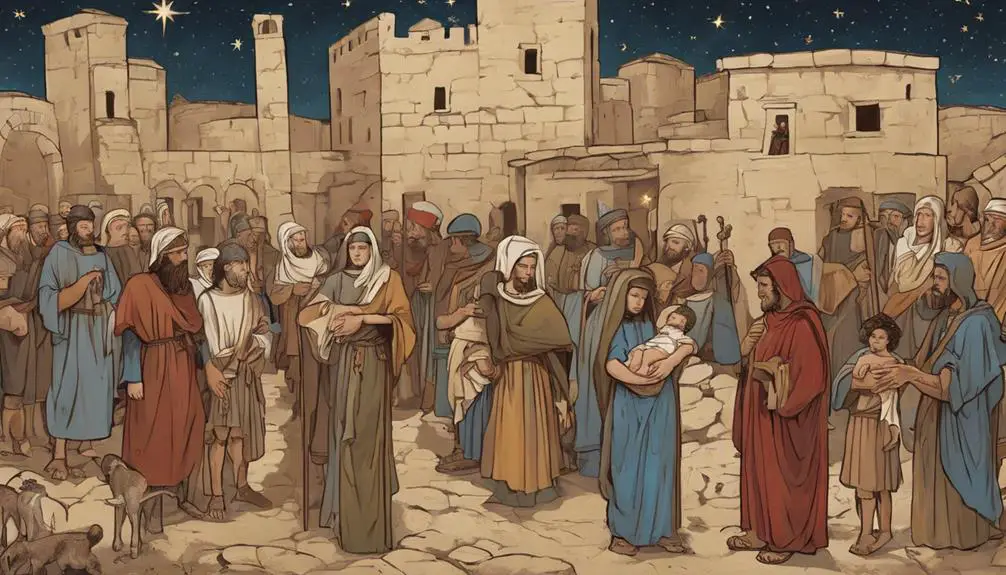Bible plotholes spark curiosity, unveiling complexities and mysteries that challenge and enrich our understanding.

Plotholes in the Bible
The Bible, while rich in spiritual guidance and historical narratives, contains some narratives that might not align perfectly under scrutiny. You've likely come across discussions about the Creation timeline, pondered the feasibility of Noah's Ark, or questioned the logistics behind the Tower of Babel. Perhaps you've even wondered about Jonah's extended stay in a whale or the census of Quirinius.
These topics, often referred to as plotholes, invite a deeper look into the text's historical and theological context. They beckon you to explore further, offering a chance to understand not just the discrepancies, but the lessons they might hold.
Key Takeaways
- Creation narratives contain contradictions, challenging a literal interpretation of timelines.
- Noah's Ark raises logistical and geological questions about a global flood.
- The Tower of Babel story offers lessons on unity and diversity, despite questions on historical events.
- The Census of Quirinius highlights discrepancies in biblical timeline and historical records.
The Creation Timeline

Analyzing the creation timeline reveals complexities and apparent contradictions that merit a thoughtful examination. You're navigating through a narrative that, at first glance, seems to flow seamlessly. However, when you delve deeper, certain elements, such as the day-night confusion and the vegetation timeline, prompt you to pause and reconsider. The text suggests that vegetation was created before the establishment of a conventional day-night cycle, an arrangement that might seem counterintuitive given the fundamental reliance of plant life on sunlight for photosynthesis.
This juxtaposition raises questions about the chronological sequence presented and its implications for understanding natural processes. It's not just about pinpointing inconsistencies but exploring the possibility that these narratives might've been intended to convey deeper, perhaps metaphorical, truths rather than serve as literal historical accounts. You're encouraged to consider the cultural and historical context in which these stories were written, as this perspective might offer insights into the intentions behind these apparent anomalies. Such an approach doesn't diminish the value of the text but rather enriches your understanding of its layers and complexities.
Noah's Ark Feasibility
Turning our attention to the narrative of Noah's Ark, we encounter questions regarding its logistical and practical feasibility. When you dive into the details, the story presents challenges, particularly in the realms of species logistics and flood geology.
Firstly, species logistics come to the forefront. You're tasked with imagining a scenario where every species on Earth is represented on a single vessel. This concept raises significant questions about space, food supply, waste management, and the care of these animals. It's not just about fitting them aboard; it's about sustaining life over a considerable period in a closed environment.
Then, there's flood geology. You've got to consider the implications of a global flood on such a scale. The geological evidence you'd expect to find from such an event presents another layer of complexity. You're looking for signs that support the occurrence of a flood capable of covering the highest mountains and reshaping the earth's surface on a global scale.
In analyzing these aspects, you're not dismissing the narrative's value or significance. Instead, you're engaging with it critically, exploring the challenges it presents from a logistical and geological perspective.
The Tower of Babel Incident

Having explored the challenges of Noah's Ark, we now shift our focus to the Tower of Babel incident, another narrative rich in complexity and interpretative challenges. This story, found in the Bible, presents a fascinating examination of human ambition, divine intervention, and the origins of linguistic diversity. You're drawn into a tale where humanity, speaking a single language, unites to build a city and a tower reaching the heavens. The architectural implications of such a structure are profound, suggesting advanced knowledge and skills in construction.
However, the narrative quickly turns to the divine response to this enterprise. Concerned by their unity and potential, God confounds their speech, resulting in the birth of linguistic diversity. This act not only halts construction but scatters humanity across the earth. You're left pondering the implications of this story on modern understandings of language and community. It raises questions about the inherent value of diversity and the limits of human ambition. Respectfully analyzing this incident, one can't help but marvel at its depth and the lessons it imparts on unity, communication, and diversity.
Jonah's Time in the Whale
In the narrative of Jonah, the prophet's time spent within the belly of a whale stands as a profound exploration of faith, obedience, and redemption. This episode, often scrutinized for its feasibility, offers a deeper reflection on the themes of whale survival and the prophet's prayer, rather than a literal account of physical endurance.
Aspect |
Symbolism |
Interpretation |
|---|---|---|
Whale's Belly |
Trial and Transformation |
A metaphor for Jonah's introspection and spiritual rebirth. |
Three Days and Nights |
Death and Resurrection |
Symbolizes Jonah's transition from disobedience to fulfillment of his prophetic mission. |
Prophet's Prayer |
Faith in Despair |
Highlights the power of prayer and repentance in the face of seemingly insurmountable challenges. |
Analyses of this passage often focus on the miraculous nature of Jonah's survival. Yet, it's the theological implications that resonate more profoundly within the narrative. Jonah's prayer from the depths signifies a pivotal moment of surrender and faith, offering readers a glimpse into the transformative power of divine intervention. This story, while presenting questions about the literal possibility of whale survival, ultimately encourages an exploration of faith's role in overcoming the impossible.
The Census of Quirinius

One notable discrepancy in biblical narratives is the Census of Quirinius, a topic that has sparked considerable debate among scholars regarding its historical accuracy and timeline within the context of the New Testament. You might find yourself puzzled by the discussions surrounding this event, especially when considering its implications on taxation and the historical timeline of the Roman Empire.
The Census of Quirinius, as described in the Gospel of Luke, mandates that all individuals return to their ancestral homes for registration. This decree, ostensibly for taxation purposes, raises questions about its historical accuracy given the lack of corroborating evidence from other historical sources outside the Bible. You should consider the taxation implications this event would have had, not just on the populace of Judea but on the administrative practices of the Roman Empire at the time.
Scholars have debated the census's timing and its synchronization with the reign of King Herod, which appears to conflict with historical records of Quirinius' governorship in Syria. This discrepancy has led some to question the New Testament's historical reliability in this instance.
As you delve deeper into this topic, it's essential to approach it with an analytical mindset, recognizing the complexities involved in reconciling biblical narratives with historical evidence.
Frequently Asked Questions
How Did Adam and Eve's Children Find Spouses if They Were the First Humans on Earth?
You're tackling a question that's puzzled many: how did the first human family expand without external partners? This scenario challenges our understanding of genetic implications and societal norms.
In analytical terms, the narrative doesn't align with modern knowledge of genetics or the development of societies. Respectfully, it seems this account may not be intended as a literal historical record but rather as a means to convey moral or spiritual lessons.
Why Does the Bible Present Differing Accounts of Judas Iscariot's Death?
You're diving into a debate where differing depictions of Judas Iscariot's demise draw attention. Apostolic tradition and scriptural interpretation shed light on these variations.
Scholars suggest that these discrepancies aren't errors but reflect diverse theological emphases or oral traditions. Analyzing these accounts, you'll see they're not simply contradictions but layers of a complex narrative, inviting deeper exploration into the texts' meanings and the early Christian community's understanding of betrayal and redemption.
How Could Moses Write About His Own Death in the Book of Deuteronomy?
You might wonder how Moses could write about his own death in Deuteronomy. It's a good question that scholars approach with different theories.
One popular explanation is the Documentary Hypothesis, suggesting multiple authors over time. Meanwhile, traditional interpretations often see Moses' death as a divine revelation or that his disciples added details posthumously.
Both perspectives aim to respectfully reconcile this apparent anomaly through analytical and scholarly exploration.
What Explains the Long Lifespans of Early Biblical Figures Such as Methuselah?
When exploring the remarkable ages of early biblical figures like Methuselah, you'll find intriguing explanations. Genetic mutations and environmental factors are often cited as potential reasons.
These ancient individuals might've possessed unique genetic qualities, coupled with an environment vastly different from today's, contributing to their extended lifespans.
It's a fascinating blend of science and scripture, offering a respectful and scholarly analysis of these storied lifetimes.
How Do Different Translations of the Bible Reconcile the Variations in the Ten Commandments?
When you explore how different translations of the Bible handle the variations in the Ten Commandments, you're delving into translation consistency and commandment origins. Scholars work meticulously to reconcile these differences, often referring back to ancient manuscripts and linguistic nuances.
They analyze the historical and cultural contexts that influenced the original texts, ensuring that translations remain as faithful as possible to the intent and meaning of those ancient laws.
Conclusion
As you've journeyed through these biblical narratives, you've encountered the enigmatic depths of ancient texts, where mysteries and marvels intertwine. The creation story, Noah's improbable voyage, Babel's ambitious ascent, Jonah's aquatic refuge, and Quirinius's controversial census—each tale invites you to ponder the fusion of faith and reason.
Navigating through these narratives with a scholarly and respectful lens illuminates the rich tapestry of human belief and its profound impact on our collective consciousness.



Sign up